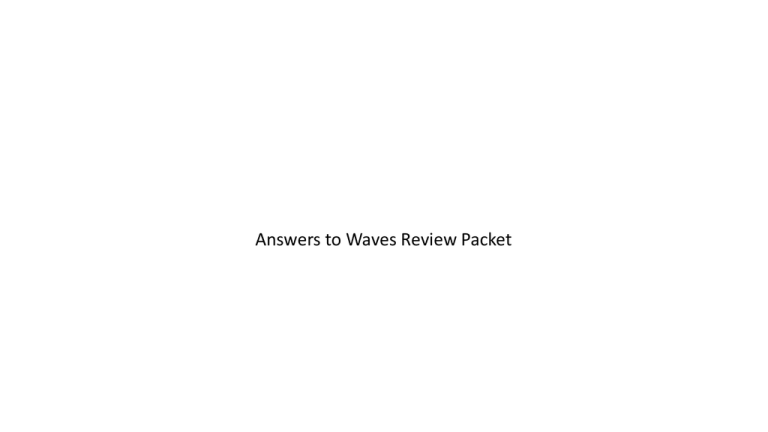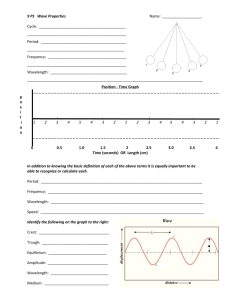Document
advertisement

Answers to Waves Review Packet 1. Draw a wave with a very high frequency and a very low frequency. high frequency low frequency 2. High frequency waves have shorter wavelengths while low frequency waves have longer wavelengths. crest crest crest Amplitude = 1.7 cm Amplitude Wavelength (λ) λ = 3.1 cm trough trough If the image shows 6 seconds, what is the frequency of the wave? f = number of cycles ÷ time so f = 3 cycles ÷ 6 seconds Therefore f = 0.5 cycles/second which means f = 0.5 Hz trough Compare and Contrast Longitudinal and Transverse Waves Longitudinal Particles move in the same direction as the direction of the wave Transverse Both are disturbances that carry energy Particles move at right angles to the direction of the wave 5. When fans do “The Wave” at a football stadium, are they making a transverse or longitudinal wave? How do you know? (Explain your answer) Fans doing the wave are making a transverse waves because the are standing up and sitting down while the wave moves from one side of them to the other. Therefore, the particles (people) are moving at right angles to the direction of the wave. Wave Speed v = λf in (m/s) Frequency f = cycles/time (Hz) Period Wavelength (λ) in (m) Amplitude (m) A v=3x2 v = 6 m/s f = 4 cycles/2 sec f = 2 Hz X 3 2 B v = 12 x 0.5 v = 6 m/s f = 1 cycle/2 sec f = 0.5 Hz X 12 2 C v=6x1 v = 6 m/s f = 2 cycles/2 sec f = 1 Hz X 6 1 7. Draw two waves cycles “in phase (crest/crest and trough, trough Give one wave an amplitude of 2 boxes and a wavelength of 4 boxes Draw another wave with the same wavelength and an amplitude of 4 boxes 8. How many wave cycles are there between the arrows in the picture shown on the right? There are 3 wave cycles. 9. If the distant between the arrows is 180 cm, what is the wavelength of this wave? 180 cm ÷3 wave cycles = 60 cm for each cycle (wavelength) 10. A swimmer at the beach notices that three wave crests pass a certain point every 10.0 seconds. She also notes that each wave crest is about 2.0 meters apart. What is the frequency of the wave that the swimmer is observing? 𝑓= 𝑛𝑢𝑚𝑏𝑒𝑟 𝑜𝑓 𝑤𝑎𝑣𝑒𝑠 𝑡𝑖𝑚𝑒 So 𝑓 = 3 𝑤𝑎𝑣𝑒𝑠 10.0 𝑠𝑒𝑐𝑜𝑛𝑑𝑠 so 𝑓 = 0.3 𝐻𝑧 What is the speed of the wave? The wavelength = 2.0 m 𝑣 = 𝜆𝑓 So 𝑣 = 2.0𝑚 × 0.3 𝐻𝑧 so 𝑣 = 0.6m/s 11. The wavelength of a sound wave in this room is 1.13 m and the frequency is 301 Hz. (remember, speed = wavelength x frequency or 𝑣 = 𝜆𝑓) a. What is the speed of the wave in the room? 𝑣 = 𝜆𝑓 so 𝑣 = 1.13𝑚 × 301𝐻𝑧 So 𝑣 = 340 𝑚/𝑠 b. If you double the frequency of the sound wave, determine its speed. So now 𝑣 = 1.13𝑚 × 602𝐻𝑧 𝑣 = 680 𝑚/𝑠 c. What happens to the wavelength if you cut the frequency in half? How do you know? Ignore this for now, we’ll discuss this in class. 12. A sound wave in a steel rail has a frequency of 620 Hz and a wavelength of 10.5 m. What is the speed of sound in steel? 𝒗 = 𝝀𝒇 so 𝒗 = 𝟏𝟎. 𝟓𝒎 × 𝟔𝟐𝟎𝑯𝒛 So 𝒗 = 𝟔𝟓𝟏𝟎 𝒎/𝒔 13. Explain how radio waves are made. Radio waves are made when a current in a wire moves backwards and forwards (oscillates). This creates a magnetic field which is also oscillating. This oscillating magnetic field sends out electromagnetic waves. 14. Explain how the types of electromagnetic waves are arranged on the electromagnetic spectrum. The electromagnetic spectrum is arranged from radio waves, which are long wavelength, low frequency, low energy waves to short wavelength, high frequency, high energy gamma rays. As you move along the spectrum from radio to gamma waves, the wavelength gets shorter and shorter while the frequency and energy gets larger and larger. 15. What are several uses for electromagnetic waves? • • • • • • • • Communication (radio waves, TV signals) Determining location and speed of objects (RADAR which uses microwaves) Cooking food (microwaves) Detecting heat sources (infrared radiation) Collecting visual information about our environment (visible light) Sterilizing medical equipment and food (ultraviolet light) Looking for injuries to bones (x-rays) Treating cancer (gamma rays) 16. In what ways can electromagnetic waves be dangerous or harmful to living things? • Sunburn, skin cancer, eye damage, aging of skin (UV) • Deeper tissue damage and cancer (x-rays, gamma rays) 15. A. B. C. D. E. F. Two waves combine to make a smaller wave. (SORRY FOR THE NUMBERING ERROR) Constructive Interference Absorption Refraction Reflection Diffraction Destructive Interference 17. A. B. C. D. E. F. When a wave bends from one medium to another (like from air to water). Absorption Destructive Interference Reflection Diffraction Constructive Interference Refraction 18. Light comes back from a mirror by: A. Diffraction B. Absorption C. Constructive Interference D. Destructive Interference E. Reflection F. Refraction 20. When a wave goes from air to glass. A. Diffraction B. Absorption C. Refraction D. Destructive Interference E. Reflection F. Constructive Interference 19. Two waves that are completely inphase will make this: A. Diffraction B. Reflection C. Absorption D. Constructive Interference E. Refraction F. Destructive Interference 21. When a wave goes around a corner. A. Constructive Interference B. Destructive Interference C. Absorption D. Diffraction E. Reflection F. Refraction 22. X-rays 23. Wavelength 24. Frequency 25. Longitudinal 26. Reflection 27. Medium 28. Visible light 29. Mechanical 30. The crest 31. Diffraction 32. The trough 33. Interference 34. Amplitude 35. Electromagnetic 36. Transverse 37. Infrared 38. Doppler Effect 39. Ultraviolet 40. Refraction 41. Radio 42. Gamma






